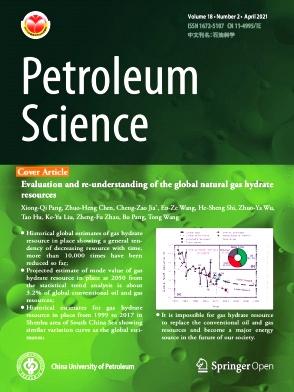Coupling analysis of transient cuttings transport and tubular mechanical behaviors in extended-reach drilling
IF 6
1区 工程技术
Q2 ENERGY & FUELS
引用次数: 0
Abstract
It is generally believed that cuttings have a significant impact on the forces of tubular string in extended-reach drilling. However, there are few studies attempted to investigate and quantify it. In this paper, a three-layer transient model for cuttings transport is established to simulate the characteristics of dynamic cuttings transport over time under various conditions. The simulation results indicate that the change in drilling parameters like ROP (rate of penetration) and flow rate of drilling fluid will lead to the non-uniform distribution of cuttings bed. And the alternation of drilling and circulation will lead to a clear wavy distribution of cuttings bed in the wellbore. Then, the effect of cuttings on tubular string is obtained through a large number of numerical simulations and the nonlinear regression method, and this influence is introduced into the conventional stiff rod model of tubular string. Finally, the transient model for cuttings transport is coupled with the modified tubular mechanic model and applies to a case study of extended-reach drilling. The results show that there is a delay effect for the effect of the changes in drilling parameters on the ground torques because the changes in drilling parameters occur instantaneously, while the changes in cuttings bed distribution are slow due to its low transport velocity. Based on the coupling analysis of transient cuttings transport and tubular mechanical behaviors, the drilling parameters are optimized, including the recommended adjustment period and adjustment range for the ROP, the proper drilling time for the increased flow rate. Furthermore, the circulation and back reaming are optimized. For circulation, the keys are choosing appropriate time interval between the two adjacent circulations and the time for each circulation. To avoid pipe stuck, at least 20 min of circulation is required to remove the cuttings bed near the large-sized BHA ((Bottom Hole Assembly)) before back reaming, and the maximum back reaming velocity should be smaller than the minimum transport velocity of the uniform bed.
求助全文
约1分钟内获得全文
求助全文
来源期刊

Petroleum Science
地学-地球化学与地球物理
CiteScore
7.70
自引率
16.10%
发文量
311
审稿时长
63 days
期刊介绍:
Petroleum Science is the only English journal in China on petroleum science and technology that is intended for professionals engaged in petroleum science research and technical applications all over the world, as well as the managerial personnel of oil companies. It covers petroleum geology, petroleum geophysics, petroleum engineering, petrochemistry & chemical engineering, petroleum mechanics, and economic management. It aims to introduce the latest results in oil industry research in China, promote cooperation in petroleum science research between China and the rest of the world, and build a bridge for scientific communication between China and the world.
 求助内容:
求助内容: 应助结果提醒方式:
应助结果提醒方式:


